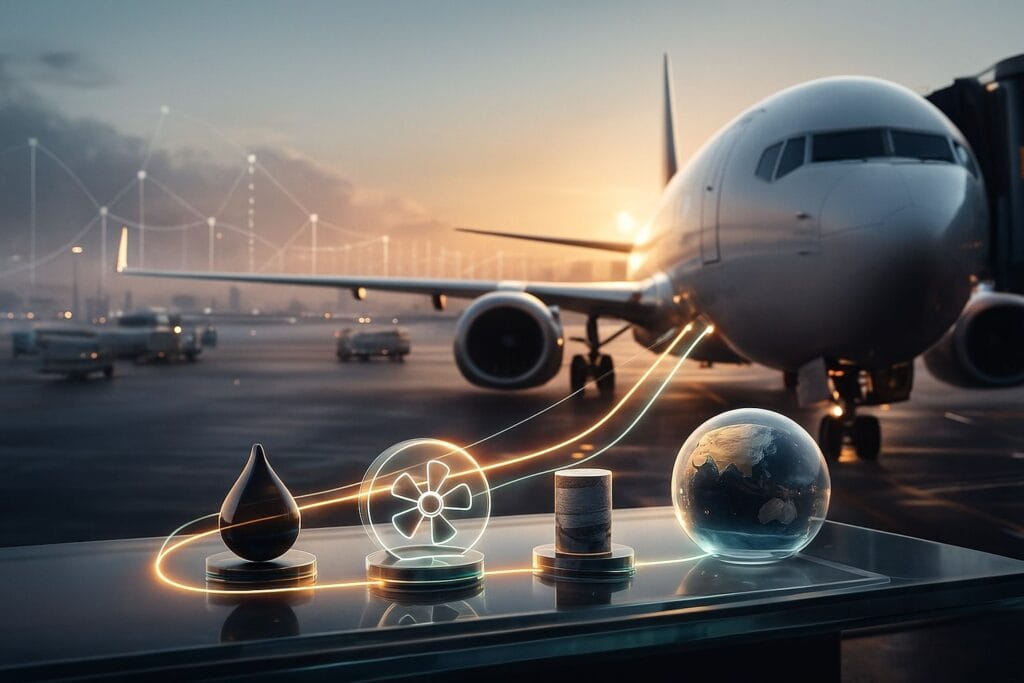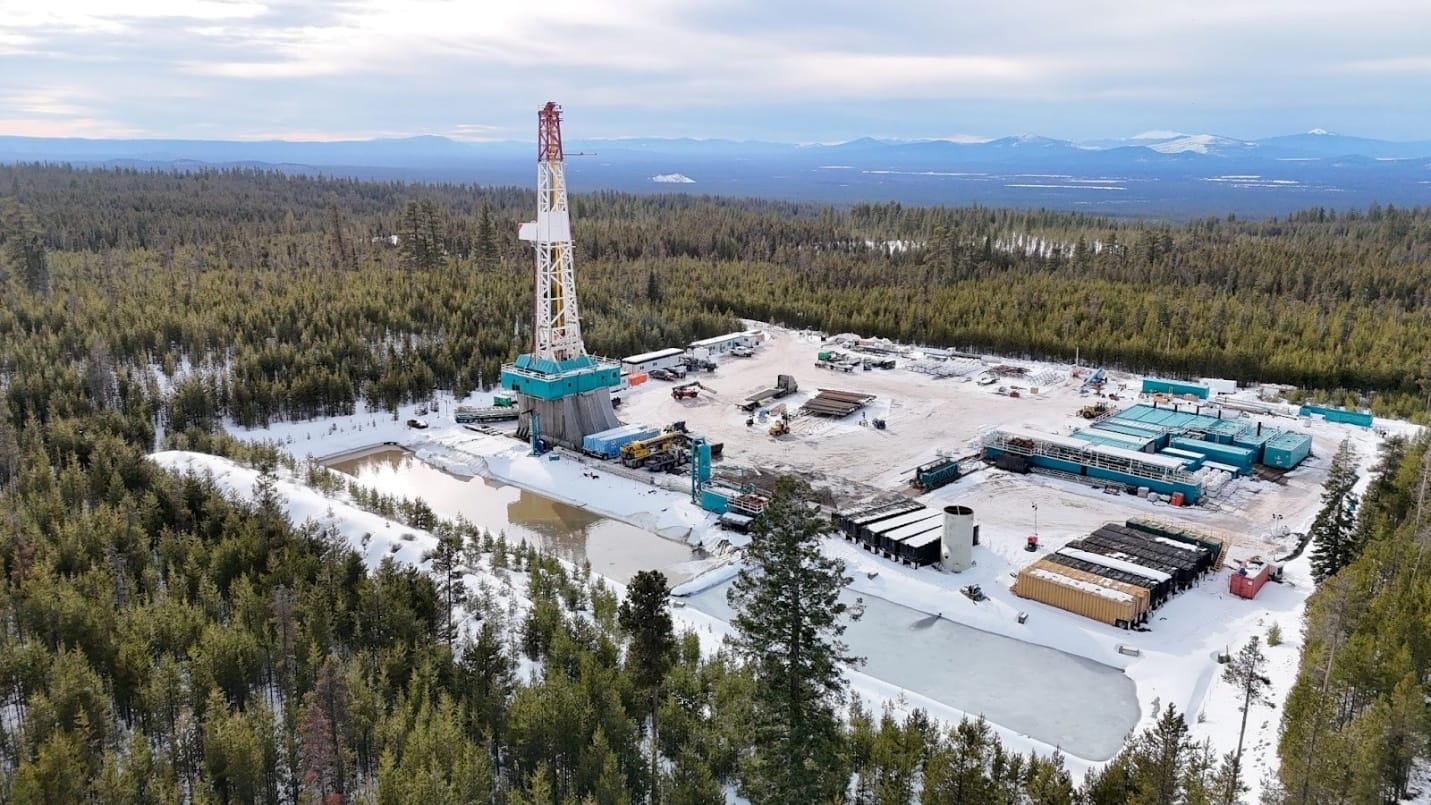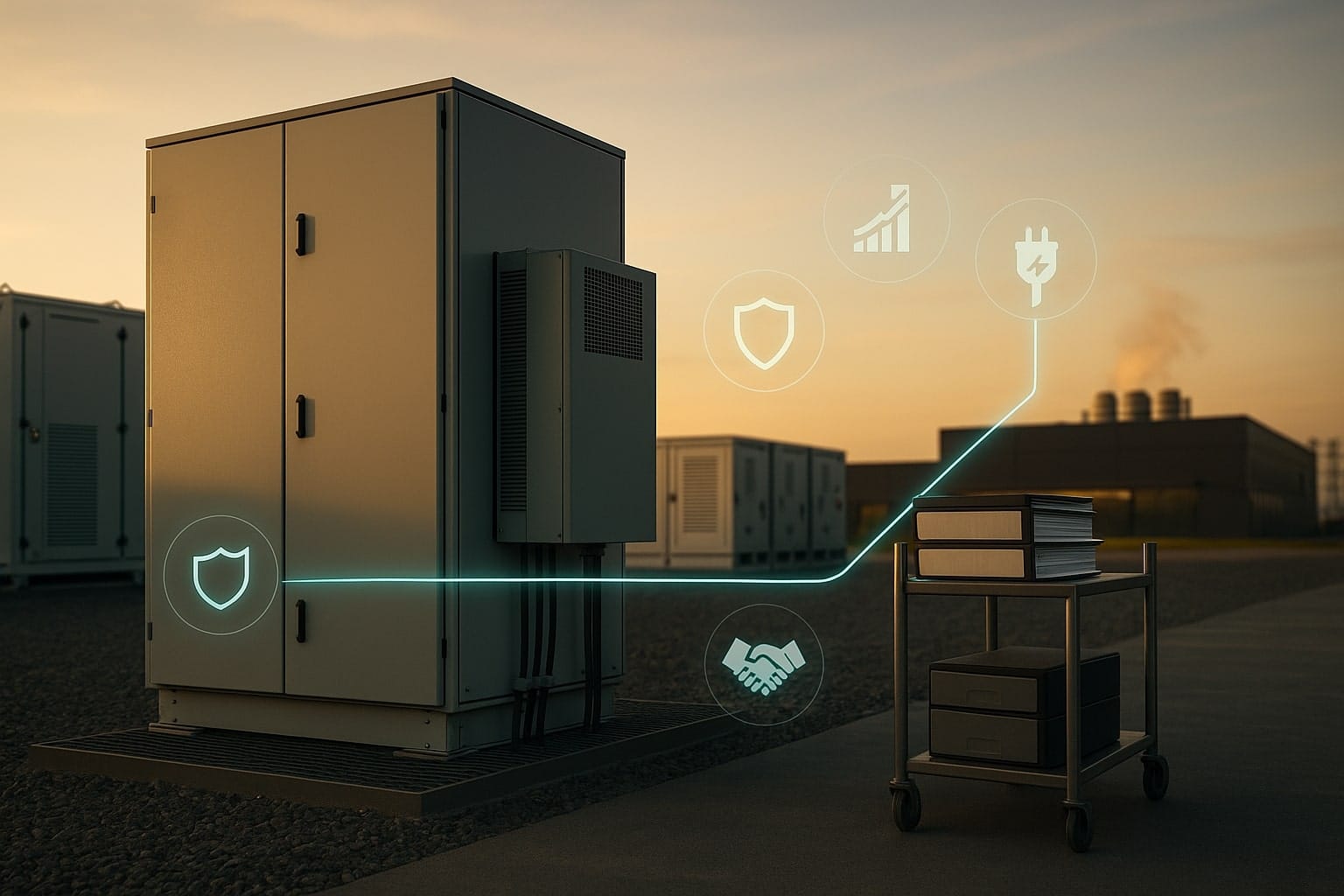Boeing’s new deal with Charm Industrial, following Airbus’s earlier agreement with Occidental’s 1PointFive, signals a subtle but important shift in how the aviation industry plans to clean up its climate tab. Sustainable aviation fuel still does most of the heavy lifting on paper – but durable carbon removal is becoming the sector’s backstop of last resort.
Table of Contents
ToggleA different kind of aviation deal
When Boeing signs a big contract, the headline numbers usually involve aircraft deliveries, defence hardware or engine parts. Its latest agreement, announced in mid-November, looks very different: up to 100,000 tonnes of carbon dioxide, purchased not as fuel or equipment, but as a promise to pull CO₂ out of the atmosphere and lock it away underground.
The supplier is Charm Industrial, a Californian start-up that takes waste biomass from forest management – wood that would otherwise rot or be burned – converts it into a viscous bio-oil and injects that oil into geological formations deep below the surface. The carbon in that oil should remain effectively out of circulation for centuries.
This is Charm’s first aviation customer, but not its first big buyer. In 2023, Frontier – the $1bn advance market commitment backed by Stripe, Alphabet, Shopify and others – agreed to pay Charm to remove 112,000 tonnes of CO₂ between 2024 and 2030, on behalf of a group of tech and finance companies.
Boeing’s move takes that early-stage climate experiment into one of the hardest sectors to decarbonise. It also highlights a deeper shift in aviation’s climate strategy: away from generic carbon offsets and towards a future in which sustainable aviation fuel (SAF), efficiency gains and permanent carbon removal are stitched together into a single, more complex playbook.
Aviation’s climate maths is unforgiving
The basic numbers are stark. In 2023, global aviation emitted almost 950 million tonnes of CO₂ – about 2.5% of energy-related emissions worldwide. That share may sound modest, but aviation is one of the fastest-growing sources of emissions: between 2000 and 2019, emissions from flying grew much faster than those from road or rail.
And CO₂ is only part of the story. High-altitude nitrogen oxides, water vapour and the contrails that aircraft leave behind trap extra heat. Recent analyses suggest that while aviation accounts for roughly 2–2.5% of global CO₂ emissions, its overall contribution to human-made warming is closer to 4%.
Demand is still rising. International Air Transport Association (IATA) forecasts assume that passenger numbers will more than double by mid-century if current trends continue. Regulators and industry bodies have nonetheless converged on a simple headline promise: net-zero CO₂ emissions from aviation by 2050. Airlines adopted that target at IATA’s 2021 annual meeting, and governments followed in 2022 when the UN aviation agency ICAO agreed a “long-term aspirational goal” of net-zero CO₂ for international flights by mid-century.
Net-zero for a sector that still runs almost entirely on fossil kerosene is not a gentle adjustment. It implies deep cuts in emissions from aircraft and fuels, plus some mechanism – almost certainly carbon removal – to neutralise whatever is left.
Why SAF cannot carry the load on its own
On paper, the workhorse solution is sustainable aviation fuel. IATA’s own roadmaps suggest that SAF could account for around 65% of the emissions reductions required to hit net-zero by 2050, with new aircraft technologies and better operations doing much of the rest.
The problem is timing and scale. Global SAF production was about 1 million tonnes in 2024 and is expected to reach roughly 2 million tonnes in 2025 – a 100% jump, but still only about 0.7% of airlines’ total fuel use. In other words, more than 99% of the fuel going into jet engines is still fossil-based.
Cost is another obstacle. IATA estimates that SAF in 2024 cost around $2,350 per tonne – roughly three times the price of conventional jet fuel – and that prices could climb to almost $2,700 per tonne in 2025, or more than four times fossil fuel. The association says that the higher SAF bill alone will add about $4.4bn to airlines’ global fuel costs in 2025.
Airlines also complain about market power. In Europe, where new rules require carriers to blend a minimum share of SAF into their fuel, IATA has accused some suppliers of “price gouging”, claiming that compliance surcharges have nearly doubled the cost of green jet fuel compared with published market benchmarks. SAF remains three to five times more expensive than kerosene on many routes.
To meet the 2050 net-zero target, IATA has floated scenarios in which global SAF output reaches hundreds of millions of tonnes a year and the world builds several thousand SAF plants. One recent industry estimate put the capital investment required at over $7tn, and suggested that average fares could be more than $1,300 higher by mid-century than they would be in a business-as-usual scenario.
The direction of travel is clear: SAF must scale, and quickly. But even optimistic roadmaps leave a residue of emissions – typically 15–20% of the sector’s 2050 footprint – that is considered too hard or too expensive to eliminate. This is the space in which permanent carbon removal is beginning to matter.

From generic offsets to “durable removal”
For two decades, the standard way to “neutralise” aviation emissions has been to buy offsets tied to projects such as forest conservation, improved cookstoves or renewable energy in developing economies. Many of these credits have done some good; many others have not. A stream of academic and investigative work has found that a large share of traditional offsets fail basic tests of additionality and permanence: the emissions cuts might have happened anyway, or the carbon stored in forests might be released later.
Critics have long worried that cheap, low-quality offsets offer airlines a way to market “carbon-neutral flights” while expanding capacity and delaying structural changes to their fuel mix. That scepticism has found its way into official policy. The International Council on Clean Transportation notes that ICAO’s 2050 net-zero goal explicitly foresees deep in-sector cuts supplemented by carbon removal, and moves away from an open-ended reliance on generic offsets.
Carbon removal is different in two important ways. First, it aims to pull CO₂ out of the atmosphere, not just avoid an alternative source elsewhere. Second, some forms of removal – those that store carbon in geological formations or long-lived mineral forms – can keep it out of circulation for thousands of years, making them better suited to compensating for fossil emissions that would otherwise linger in the climate system for centuries.
Durable carbon removal comes in several flavours: bio-oil injection, as used by Charm; direct air capture (DAC), where fans and sorbents are used to strip CO₂ directly from ambient air; mineralisation, which binds CO₂ into rock; and bioenergy with carbon capture and storage (BECCS), which combines biomass combustion with CO₂ capture at power plants. Each has its own land, energy and cost constraints – and none is cheap.
In 2024, purchase prices for DAC on the voluntary market ranged from around $100 to as much as $2,000 per tonne, with an average of about $490. Across the broader portfolio of durable carbon removal technologies, the weighted average price per tonne disclosed in public deals fell from roughly $490 in 2023 to about $320 in 2024 as early projects scaled, according to tracking by cdr.fyi.
Even at those lower prices, permanent removal is orders of magnitude more expensive than many legacy offsets, which have often traded in the low-tens of dollars per tonne. That gap is precisely the point. By paying hundreds of dollars per tonne, early buyers are not only trying to clean up their own emissions, but also to build an economic case for technologies that might, in time, become cheap enough to deploy at climate-relevant scale.
Aviation’s carbon-removal portfolio is taking shape
Boeing’s deal with Charm is one of the most prominent aviation-linked carbon-removal contracts to date, but it is not the first. Airbus has already agreed to buy 400,000 tonnes of removal credits from 1PointFive, a subsidiary of Occidental Petroleum that plans to build a one-million-tonne-per-year DAC facility in Texas using technology from Carbon Engineering.
Under that arrangement, Airbus will pre-purchase 100,000 tonnes of removals a year for four years and has launched an “Airbus Carbon Capture Offer” to resell those credits to airline customers that want to neutralise part of their emissions profile with DAC-based removals.
Individual airlines are also beginning to assemble their own portfolios. British Airways has signed an agreement with Climeworks, the Swiss DAC company, under which Climeworks will permanently remove a small share of the carrier’s emissions from the air. BA frames the partnership explicitly as a way to stimulate the carbon-removal market alongside in-sector measures to cut fuel burn.
For now, the numbers are tiny. Even if Boeing takes the full 100,000 tonnes of removal from Charm, that would compensate for just a fraction of one per cent of annual global aviation emissions. Airbus’s 400,000-tonne pre-purchase, spread over four years, is also modest in sectoral terms.
But the symbolic shift matters. These are multi-year offtake agreements, not one-off purchases of generic credits. They signal to investors and policymakers that aviation expects to lean on high-durability carbon removal for a defined slice of its 2050 target – and is willing to sign cheques at today’s high prices to help bring that future closer.
The “new stack”: efficiency, SAF and removals
Industry roadmaps now tend to converge on a similar architecture for decarbonising flight:
- Efficiency and operations. Airlines squeeze more out of existing fleets through better routing, higher load factors and incremental improvements to air-traffic management. New aircraft designs deliver further fuel savings.
- Fuel switching. SAF, made from waste oils, biomass or synthetic “power-to-liquid” pathways, gradually displaces fossil kerosene. IATA expects SAF to provide most of the emissions reduction by 2050, provided that production can be scaled from today’s 2 million tonnes a year to several hundred million.
- New propulsion. Hydrogen and battery-electric aircraft may carve out niches on shorter routes from the 2030s onwards, but are unlikely to dominate long-haul aviation by mid-century.
- Permanent carbon removal. For the residual emissions that remain even after aggressive deployment of these measures – estimated at roughly 200 million tonnes of CO₂ a year in some scenarios – airlines and manufacturers turn to high-durability removal.
In this vision, CDR is not a licence to keep burning fossil fuel unabated; it is a safety net for the last slice of emissions that cannot otherwise be eliminated at reasonable cost. Both IATA and ICAO stress that removals should complement, not substitute, direct reductions in fuel use and intensity.
For Boeing and Airbus, the shift also has a strategic dimension. By brokering carbon-removal deals for their customers, they position themselves not just as hardware suppliers but as climate-solution partners – an attractive message in an era when corporate buyers face growing scrutiny over the credibility of their net-zero claims.
Who pays – and will passengers notice?
The economics of this “new stack” are still fluid.
At a notional price of $300–$600 per tonne, Boeing’s 100,000-tonne deal with Charm might cost somewhere between $30m and $60m over its life – a rounding error for a group generating more than $66bn in annual revenue, even after recent losses.
Spread across hundreds of millions of passengers a year, the direct impact on ticket prices looks small. The SAF bill tells a different story. Because SAF is blended into fuel for everyday operations, and is several times more expensive than kerosene, it feeds straight into operating costs. IATA estimates that higher SAF prices alone will add billions of dollars a year to airlines’ fuel bills well before 2030, with a cumulative decarbonisation cost running into the trillions of dollars through to 2050.
In practice, who pays depends on a mix of regulation, competition and public tolerance. Airlines have already started to pass some costs on through higher fares and optional “green” surcharges. Governments, meanwhile, are implicitly subsidising parts of the transition via tax credits for low-carbon fuels and grants for demonstration projects. Corporate travellers, under pressure to hit their own climate targets, are signing “book-and-claim” deals through platforms such as Shell’s Avelia, effectively paying a premium to underwrite SAF on routes they may never physically fly.
CDR contracts add another layer. At current prices, even modest volumes of durable removal can quickly run into tens or hundreds of millions of dollars over the life of an agreement. Early buyers like Boeing and Airbus can justify those costs as part research-and-development, part reputational hedge. For airlines, the question is whether CDR becomes a standard component of long-haul ticket prices – a sort of embedded climate surcharge – or remains a niche offer marketed to climate-conscious corporate clients.
Either way, the direction of travel is clear: there is no plausible path to net-zero aviation in which passengers are not paying more, whether through fares, taxes or some combination of the two.
The credibility test: physics vs marketing
If the sector’s new climate strategy has a weakness, it lies in public trust. After years of exuberant claims about “carbon-neutral flights” based on cheap offsets, many travellers and campaigners are understandably sceptical of any scheme that promises to square rising traffic with climate targets.
Several fault lines are already visible:
- Additionality and permanence. Even high-durability CDR projects must prove that their removals are genuinely additional and will stay put. That means robust monitoring, reporting and verification (MRV), and clear rules about liability if storage fails.
- Feedstock and land use. Bio-oil and BECCS projects depend on sustainable biomass. If demand scales too quickly, there is a risk that they start to compete with other land uses, undermining their climate benefit. Charm’s focus on forest-waste from wildfire-prevention work is one way to reduce this risk, but it will not solve it globally.
- Moral hazard. Perhaps the most contentious question is whether access to CDR will encourage airlines and manufacturers to delay tougher decisions on demand management, fleet rationalisation or slot allocation. Industry bodies insist that removals are intended only for residual emissions, but the line between “residual” and “avoidable” is likely to be contested for years.
Regulators are starting to respond. Standards for which removals can be used under ICAO’s CORSIA scheme, or counted against national targets, are tightening. Some corporate disclosure frameworks now distinguish sharply between emissions reductions and neutralisation via removals, forcing companies to spell out how much of their net-zero strategy relies on each.
For aviation, that transparency will be crucial. If airlines present CDR as a substitute for cutting fossil fuel use rather than as a last-resort complement, the backlash is likely to be swift.
What to watch over the next decade
Boeing’s agreement with Charm, and Airbus’s partnership with 1PointFive, do not solve aviation’s climate problem. But they do offer a early glimpse of what the sector’s “end-game” might look like if governments and companies stick to their 2050 promises.
Several signposts will reveal whether this new playbook is serious:
- SAF build-out vs rhetoric. Does SAF production really climb beyond 2 million tonnes a year and start to take visible market share from fossil jet fuel – or does it stall in the single-digit percentages while traffic keeps growing?
- CDR volume and pricing. Do durable removals remain a boutique product bought by a handful of large companies, or do annual contracted volumes – across all buyers – scale from today’s hundreds of thousands of tonnes to tens of millions, with prices continuing to fall from the current few-hundred-dollars-per-tonne range?
- Integration into regulation. Do aviation regulators and standard-setters explicitly recognise high-durability CDR as a tool for neutralising residual emissions, while closing the door on low-quality offsets? Or do inconsistent rules create opportunities for greenwashing?
- Ticket-price politics. Do governments and airlines prepare passengers early for higher fares linked to climate measures, or does the sector try to defer the costs until they become unavoidable – and politically explosive?
If the answers tilt in the right direction, Boeing’s 100,000-tonne bio-oil contract may come to be seen as one of the early markers of aviation’s turn from “offsetting” to genuine carbon removal. If they do not, it will look more like another clever financial instrument bolted onto an unchanged business model.
For now, the industry has made its long-term promise: net-zero CO₂ by 2050. The challenge is to align the physics of aircraft, fuels and the atmosphere with the economics of tickets, subsidies and investor expectations – and to prove, tonne by tonne, that permanent removal is more than just a line item on a sustainability slide.












